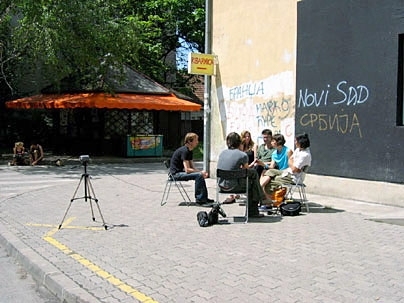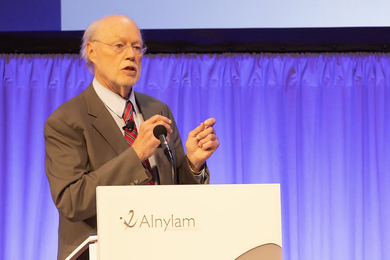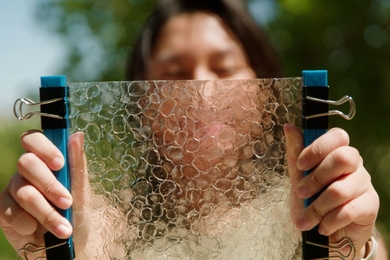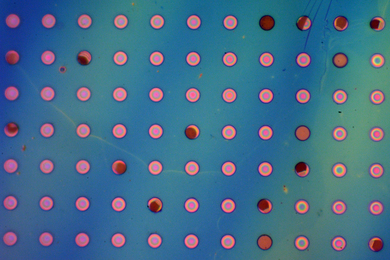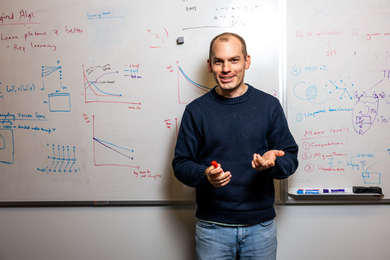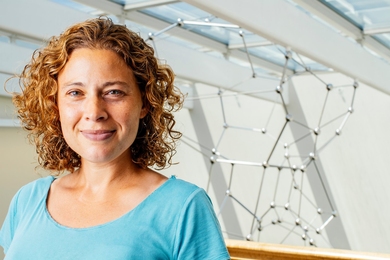Soon after Meg Rotzel arrived in Ljubljana, Slovenia, this past July, she met up with 25 strangers at an art gallery, and they all set out to spend the next three days together--as fellow travelers on the Lost Highway Expedition.
The expedition, which ran from July 30 to Aug. 24 in the Western Balkans, drew some 300 people to what its organizers called "a massive intelligent swarm" of individuals, groups and institutions from the United States, Europe and elsewhere. The expedition was loosely centered around art, architecture and culture.
Rotzel, curatorial associate for MIT's Center for Advanced Visual Studies (CAVS), became intrigued by the ambitious project when she worked with some of the event's planners at CAVS.
Three of the eight organizers have MIT connections: Marjetica Potrc is a 2004 CAVS fellow; Azra Aksamija is a 2005-2006 CAVS graduate affiliate from Sarajevo; and Kyong Park is a 2006 CAVS visiting artist. The founders began the project by building connections with regional artists and architects, then set up the web site www.europelostandfound.net to attract others.
Rotzel joined the expedition for two weeks, traveling with various groups along the former Yugoslavia's unfinished "Highway of Brotherhood and Unity." Begun in the 1960s, the road was designed to connect Ljubljana, Zagreb, Belgrade and Skopje as part of a massive voluntary campaign by former Yugoslav leader Josip Broz Tito to facilitate trade and join nations.
Now, its ideology lost, the road looks like any highway. It runs through Albania, Bosnia and Herzegovina, Croatia, Macedonia, Serbia and Montenegro--most of which were once part of Yugoslavia, now fractured into pieces.
The Lost Highway Project thus illustrates the first theme in a larger project called Europe Lost and Found. That project will follow three major themes over the next few years: "Balkanization" (2006-2007), "Europeanization" (2007-2008) and "Map the Future" (2008-2009).
The highway--and the expedition--began in Ljubljana and wound through Zagreb, Novi Sad, Belgrade, Skopje, Pristina, Tirana,��Podgorica, Pristina and Sarajevo. Each city hosted two days of events, which included guided tours, presentations, forums, workshops, discussions,��exhibitions, radio shows and picnics.
Other events were organized at the last minute by travelers and locals alike. Some participants created art on the spot. Rotzel, who kept an illustrated travel diary, took photos and video footage of her experience. She said she was amazed by the success of the self-organizing events.
Rotzel gathers artists together for performance and publication-based art, so she knows first-hand the challenge of making art events click for diverse audiences. The expedition's goal, as she saw it, was "to think about cultural production in each city by reading the architecture and the projects of artists like a map. Each city was a different experience.
"Autonomy and collaboration had an equal hand in the trip, which made a deep impression on me," she said.
The Lost Highway Expedition was a collaboration between the Centrala Foundation for Future Cities and the School of Missing Studies, a network for experimental study of cities marked by or currently undergoing abrupt transition.
Rotzel received a grant from the MIT Office of the Arts to cover her travel costs, and her trip photos, video and other documentation are now on display in CAVS's front gallery, N52-390. And, on Oct. 25-26, members of the expedition will lead programs at CAVS.
According to expedition organizers, the event was meant to "generate new projects, new artworks, new networks, new architecture and new politics based on experience and knowledge found along the highway." Projects developed from the expedition will lead to exhibitions, publications and symposia of "Europe Lost and Found" in Ljubljana and Stuttgart, Germany in 2007.
A version of this article appeared in MIT Tech Talk on September 27, 2006 (download PDF).
